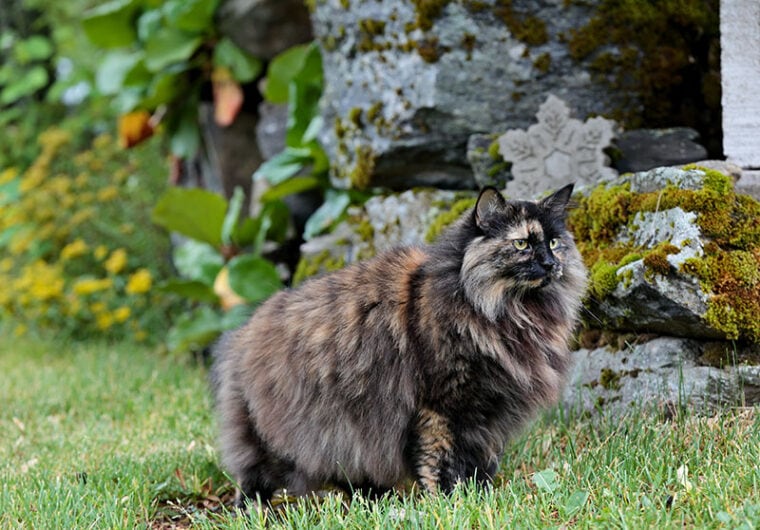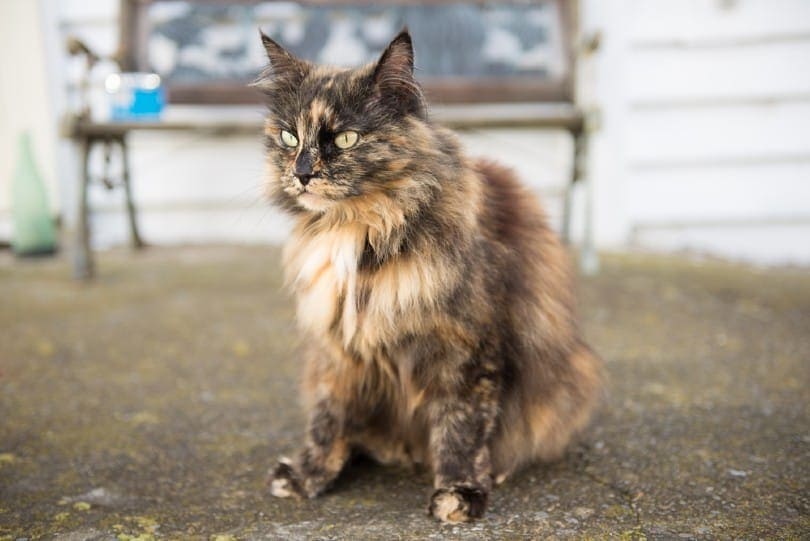
Click to Skip Ahead
Norwegian Forest cats are large, fluffy cats with gentle personalities. These affectionate cats are agreeable companions with a lot of love to give, making them beloved by many cat lovers worldwide. If you want to bring a Norwegian Forest cat home, make sure you are ready to provide it with lots of attention, plenty of brushing, and several perches to climb!
Breed Overview
Height:
9–12 inches
Weight:
12–16 pounds
Lifespan:
14–16 years
Colors:
White, black, red, blue, gray, lavender, silver, tan, cream
Suitable for:
Families with other pets, families that can dedicate time to extensive grooming
Temperament:
Bold, social, and affectionate
Tortoiseshell is a unique color pattern. Typically, tortoiseshell cats have a combination of two colors in their fur (not including white) that is either mixed evenly through their coat or separated into larger patches. These colors are often orange and black, although they vary in shade. The Tortoiseshell Norwegian Forest cat creates a striking image with long, beautifully colored fur.
Tortoiseshell Norwegian Forest Characteristics

The Earliest Records of the Tortoiseshell Norwegian Forest Cat in History
Norwegian Forest cats are an old breed. Although specific details about the origin of the Norwegian Forest cat are unknown, it is believed that Vikings may have kept the cats on their ships to hunt and kill mice. Because of this, the breed is considered native to Norway.
Since the Norwegian Forest cat likely traveled on boats with the Vikings, it is possible that the breed spread throughout the world long ago. For instance, it’s believed that the Vikings brought the Norwegian Forest cat to North America in the late 900s. However, the breed would not be recognized in America until centuries later.
In Norway, the Norwegian Forest cat was more readily accepted as a breed due to the work of the Norwegian Forest Cat Club, which established structured breeding programs to develop the Norwegian Forest cat. Their breeding efforts helped to establish the breed with the European Fédération Internationale Féline in the 1970s.

How the Tortoiseshell Norwegian Forest Cat Gained Popularity
Norwegian Forest cats were relatively unknown throughout the world for a long time, even though the breed’s history dates back centuries. These cats lived under the radar as domestic cats until 1938, when a Norwegian Forest cat was displayed at an international cat fancy show. Many show attendees were impressed by the beauty and majesty of the Norwegian Forest cat, and it left quite an impression.
Afterward, the Norwegian Forest Cat Club was formed from passionate devotees of the breed. This club was dedicated to protecting and developing the Norwegian Forest cat. In the 1950s, the Norwegian Forest cat was declared the official cat of Norway by King Olav V.
The Norwegian Forest cat remains somewhat rare in the United States, but it is incredibly popular in Scandinavia, China, and France. Although they are less common in the United States, they tend to be fan favorites whenever they appear at shows.
Formal Recognition of the Tortoiseshell Norwegian Forest Cat
After the Norwegian Forest Cat Club’s extensive development and promotion of the Norwegian Forest cat, the Fédération Internationale Féline bestowed the breed with official worldwide recognition in 1977.
In 1987, the Norwegian Forest Cat was presented to the Cat Fanciers’ Association (CFA) board for registration acceptance. In 1993, the Norwegian Forest cat was accepted for championship status.
The breed standard accepts the tortoiseshell coloration, meaning that the Tortoiseshell Norwegian Forest cat is officially recognized. The breed standard dictates that Tortoiseshell Norwegian Forest cats must have black fur with patches of red or areas blended with red hair. Different shades of red are accepted.

 Top 4 Unique Facts About the Tortoiseshell Norwegian Forest Cat
Top 4 Unique Facts About the Tortoiseshell Norwegian Forest Cat
1. There Are Different Types of Tortoiseshell Cats
Among tortoiseshell cats, there are several pattern variations. The most common is the mosaic coat, in which the tortoiseshell cat’s colors are randomly blended across the body. There is also the chimera coat, where the Tortoiseshell cat has one color on one side of the body and the other color on the opposite. Likewise, tortoiseshell coats may be brindled or patched. Brindled coats appear woven together, whereas patched coats appear in prominent sections.
2. Almost All Tortoiseshell Cats are Female
More often than not, a Tortoiseshell cat that you spot will be female. This is because female sex chromosomes carry the genes for orange and black fur. Only cats with two female sex chromosomes (X) can be both orange and black at the same time.
However, that does not mean that a male Tortoiseshell cat can’t exist. There have been instances in which a male cat’s sex genes mutated, causing him to have two female sex chromosomes (allowing him to have the tortoiseshell coloration).
3. Norwegian Forest Cats Are Immortalized in Legend
Although it may be easy to think that the Norwegian Forest cat is simply a fluffy housecat, that couldn’t be farther from the truth. The cat is legendary.
In Norwegian myths, there are stories of the skogkatt, a large cat with long hair that could scale landmarks that other cats could not. The Norwegian Forest cat is believed to be the source of inspiration behind this myth.
4. Tortoiseshell Cats Also Have a Place in Folklore
Norwegian Forest cats aren’t the only mythologized cats—the Tortoiseshell cat also has its fair share of folklore. For instance, if a male Tortoiseshell cat enters a home in Scotland or Ireland, it is considered good luck. Meanwhile, in the United States, Tortoiseshell cats are known as “money cats.”
Does the Tortoiseshell Norwegian Forest Cat Make a Good Pet?
The Tortoiseshell Norwegian Forest cat makes an excellent family pet. They are outgoing, friendly cats that are happy to make new friends out of strangers. They are also incredibly affectionate, always looking for opportunities to brush up against you.
Since the Norwegian Forest cat has such long, thick fur, you must be ready to brush it often. During regular seasons, brushing two times per week is adequate. However, during shedding season, you must brush your cat more frequently.
The Tortoiseshell Norwegian Forest cat will require a lot of activity, so make sure that you have plenty of room in your home for it to run, climb, and perch. Toys will be necessary to keep this frisky kitty entertained and satisfied.
Conclusion
The Tortoiseshell Norwegian Forest cat is a unique and beautiful cat with long, luxurious fur. The history of the Norwegian Forest cat is long and fascinating, although the breed was not officially recognized for centuries. Although the Norwegian Forest cat is uncommon in the United States, it is still popular at shows and around the world. Combining this breed with the Tortoiseshell coloration is a sure way to create a stunning cat that everyone will want to see.
Featured Image Credit: Elisa Putti, Shutterstock




